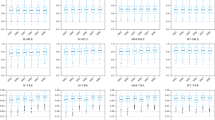Abstract
This article proposes an extension to the typical random-coefficients frontier model that allows the incorporation of firm management indicator(s) in the distribution of firms’ technology parameters. Such a modelling approach does not only relax the homogeneous technology assumption but also empirically tests for the factors that may be responsible for variation in firms’ technology parameters. The proposed approach is used to measure the technical efficiency of German dairy farms for the period 2001–2009. Estimation is performed using Bayesian techniques. The empirical findings suggest that German dairy farms achieve high levels of technical efficiency, while farms’ degree of intensification indeed drives several technology parameters. Furthermore, model comparison based on Bayes factors reveals that the employed model outperforms a simple stochastic frontier model and a random-coefficients stochastic frontier model.
Similar content being viewed by others
Notes
A formal model comparison is performed in the application that follows between the Cobb–Douglas and a translog specification.
An illustration of estimating a stochastic frontier model using Maximum Likelihood can be found in Abid and Goaied (2017).
Data source: EU-FADN DG AGRI.
Formal model comparisons based on Bayes factors suggest that a Cobb-Douglas specification is favored by the data when compared to a translog in all three models. The results can be provided upon request.
An estimated parameter is statistically significant if it’s corresponding 90% Interval does not contain zero.
This can be infered by whether the 90% Interval of the estimates with respect to the intensification variable contain zero.
References
Abid, I., and M. Goaied. 2017. Benchmarking banking efficiency using a meta-profit function. Journal of Quantitative Economics 15 (1): 45–74.
Aigner, D., C.A.K. Lovel, and P. Schmidt. 1977. Formulation and estimation of stochastic frontier production function models. Journal of Econometrics 6 (1): 21–37.
Alvarez, A., and J. del Corral. 2010. Identifying different technologies using a latent class model: extensive versus intensive dairy farms. European Review of Agricultural Economics 37 (2): 231–250.
Alvarez, A., J. del Corral, D. Solís, and J.A. Pérez. 2008. Does intensification improve the economic efficiency of dairy farms? Journal of Dairy Science 91 (9): 3693–3698.
Emvalomatis, G. 2012. Productivity growth in German dairy farming using a flexible modelling approach. Journal of Agricultural Economics 63 (1): 83–101.
Greene, W. 2005. Reconsidering heterogeneity in panel data estimators of the stochastic frontier model. Journal of Econometrics 126 (2): 269–303.
Hynes, S., and E. Garvey. 2009. Modelling Farmers’ participation in an agri-environmental scheme using panel data: an application to the rural environment protection scheme in Ireland. Journal of Agricultural Economics 60 (3): 546–562.
Kalirajan, K.P., and M.B. Obwona. 1994. Frontier production function: The stochastic coefficients approach. Oxford Bulletin of Economics and Statistics 56 (1): 87–96.
Kass, R.E., and A.E. Raftery. 1995. Bayes factors. Journal of the American Statistical Association 90 (430): 773–795.
Koop, G., M.F.J. Steel, and J. Osiewalski. 1995. Posterior analysis of stochastic frontier models using Gibbs sampling. Computational Statistics 10: 353–373.
Kumbhakar, S. C. and C. A. K. Lovell. 2003. Stochastic frontier analysis. Cambridge: Cambridge University Press.
Lewis, S.M., and A.E. Raftery. 1997. Estimating bayes factors via posterior simulation with the Laplace-metropolis estimator. Journal of the American Statistical Association 92 (438): 648–655.
Meeusen, W., and J. van den Broeck. 1977. Efficiency estimation from Cobb–Douglas production functions with composed error. International Economic Review 18 (2): 435–444.
Orea, L., and S.C. Kumbhakar. 2004. Efficiency measurement using a latent class stochastic frontier model. Empirical Economics 29 (1): 169–183.
Reinhard, S., C.A.K. Lovell, and G. Thijssen. 2002. Analysis of environmental efficiency variation. American Journal of Agricultural Economics 84 (4): 1054–1065.
Sauer, J., and C.J.M. Paul. 2013. The empirical identification of heterogeneous technologies and technical change. Applied Economics 45 (11): 1461–1479.
Tanner, M.A., and W.H. Wong. 1987. The calculation of posterior distributions by data augmentation. Journal of the American Statistical Association 82 (398): 528–540.
Tsionas, E.G. 2002. Stochastic frontier models with random coefficients. Journal of Applied Econometrics 17 (2): 127–147.
van den Broeck, J., G. Koop, J. Osiewalski, and M.F.J. Steel. 1994. Stochastic frontier models: A Bayesian perspective. Journal of Econometrics 61 (2): 273–303.
Author information
Authors and Affiliations
Corresponding author
Rights and permissions
About this article
Cite this article
Skevas, I. A Hierarchical Stochastic Frontier Model for Efficiency Measurement Under Technology Heterogeneity. J. Quant. Econ. 17, 513–524 (2019). https://doi.org/10.1007/s40953-018-0144-5
Published:
Issue Date:
DOI: https://doi.org/10.1007/s40953-018-0144-5




